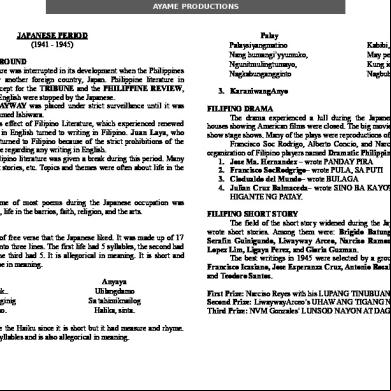Philippine Lit During Japanese Period 432i51
This document was ed by and they confirmed that they have the permission to share it. If you are author or own the copyright of this book, please report to us by using this report form. Report 3b7i
Overview 3e4r5l
& View Philippine Lit During Japanese Period as PDF for free.
More details w3441
- Words: 295
- Pages: 11
JAPAN
Advantageous Effect on Filipino Literature Writers in English turned in writing Filipino
Ex. Juan Laya By this time the “LIWAYWAY” was placed under the surveillance until it was managed by a Japanese named Ishiwara.
Advantageous Effect on Filipino Literature
Advantageous Effect on Filipino Literature Filipino literature was given a break during this period. Writers wrote: Plays, Poem, Short Stories, etc. Life in the province - common topic and theme
FILIPINO POETRY DURING THIS PERIOD Themes for Poems: nationalism
faith
country
religion
love
arts
life in the barrios
3 Types of Poems 1. HAIKU a poem of free verse that the Japanese liked. It was made up of 17 syllables divided into three lines. The first line had 5 syllables, the second 7 syllables and the third have 5. The HAIKU is allegorical in meaning, in short and covers a wide scope in meaning.
Examples:
Haiku By Gonzalo K. Flores
Tutubi
Dragonfly
Hila mo’y tabak… Ang bulaklak, nanginig! Sa paglapit mo.
You’re pulling a saber The flowers shivered When you approached
Anyaya
Invitation
Ulilang damo Sa tahimik na ilog Halika, sinta.
Lonely grass By the quiet river Come, love
2. TANAGA like the HAIKU, is short but it had measure and rhyme. Each line had 7 syllables and is also allegorical in meaning. Examples:
Tanaga ni Ildefonso Santos
Palay Palay siyang matino Nang humangi’y yumuko, Ngunit muling tumayo, Nagkabunga ng ginto.
Palay He’s a behave palay Who bowed when the wind blews But stood up again And bore gold.
Kabibi Kabibi, ano ka ba? May perlas maganda ka Kung idikit sa tainga Nagbubuntunghininga.
Shell
Shell, hey! You’re beautiful pearl If you are pressed to the ears You sigh.
3. KARANIWANG ANYO (USUAL FORM)
Other samples of HAIKU is made by Rodolfo S. Rosales.
Advantageous Effect on Filipino Literature Writers in English turned in writing Filipino
Ex. Juan Laya By this time the “LIWAYWAY” was placed under the surveillance until it was managed by a Japanese named Ishiwara.
Advantageous Effect on Filipino Literature
Advantageous Effect on Filipino Literature Filipino literature was given a break during this period. Writers wrote: Plays, Poem, Short Stories, etc. Life in the province - common topic and theme
FILIPINO POETRY DURING THIS PERIOD Themes for Poems: nationalism
faith
country
religion
love
arts
life in the barrios
3 Types of Poems 1. HAIKU a poem of free verse that the Japanese liked. It was made up of 17 syllables divided into three lines. The first line had 5 syllables, the second 7 syllables and the third have 5. The HAIKU is allegorical in meaning, in short and covers a wide scope in meaning.
Examples:
Haiku By Gonzalo K. Flores
Tutubi
Dragonfly
Hila mo’y tabak… Ang bulaklak, nanginig! Sa paglapit mo.
You’re pulling a saber The flowers shivered When you approached
Anyaya
Invitation
Ulilang damo Sa tahimik na ilog Halika, sinta.
Lonely grass By the quiet river Come, love
2. TANAGA like the HAIKU, is short but it had measure and rhyme. Each line had 7 syllables and is also allegorical in meaning. Examples:
Tanaga ni Ildefonso Santos
Palay Palay siyang matino Nang humangi’y yumuko, Ngunit muling tumayo, Nagkabunga ng ginto.
Palay He’s a behave palay Who bowed when the wind blews But stood up again And bore gold.
Kabibi Kabibi, ano ka ba? May perlas maganda ka Kung idikit sa tainga Nagbubuntunghininga.
Shell
Shell, hey! You’re beautiful pearl If you are pressed to the ears You sigh.
3. KARANIWANG ANYO (USUAL FORM)
Other samples of HAIKU is made by Rodolfo S. Rosales.










